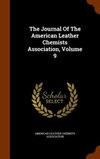Effect of Electrostatic Interaction between Collagen and Enzymes on Permeation of Protease into the Pelt during Leather Bating Process
IF 0.5
4区 工程技术
Q4 CHEMISTRY, APPLIED
Journal of The American Leather Chemists Association
Pub Date : 2023-10-02
DOI:10.34314/jalca.v118i10.8231
引用次数: 0
Abstract
The enzymatic delimed pelts bating process using proteases is critical to improving the overall performance of the leather. Bating effectiveness is determined not only by the properties but also by the permeation behavior of the proteases. Imperfect methods to control protease permeation often results in uneven distribution of enzyme proteins in the pelts, leading to excessive enzymolysis of the surface layer and inadequate opening-up of the inner layer. In this study, the relative size of proteases and delimed pelts were analyzed, the permeation behavior of fluorescein-labeled proteases in the pelt was observed using a confocal laser scanning microscope (CLSM), and the effect of electrostatic interaction between protease and collagen proteins on the permeation of protease into the pelt was investigated. The results showed that, after dehairing, liming and deliming operations, the enzyme can easily permeate into the pelts due to the formation of large cavities and interfibrillar gaps. The permeation of protease within the delimed pelt is significantly influenced by the affinity (electrostatic interactions) between the collagen and protease proteins. The isoelectric point (pI) of the protease protein, the collagen and the pH of the solution directly influence the electrostatic properties and interactions. When the enzyme and collagen are similarly charged (electrostatic repulsion), the enzyme can easily permeate into the pelts; when the enzyme and collagen are oppositely charged (electrostatic attraction), the permeation of the enzyme into the inner layer is difficult, resulting in the accumulation of protease on the grain and excessive hydrolysis of the grain layer. Therefore, the established permeation regulation mechanism of protease based on electrostatic interactions between enzyme and collagen could serve as an important basis for the selection of protease and the regulation of the enzymatic bating process.胶原蛋白与酶之间的静电相互作用对皮革打浆过程中蛋白酶渗入毛皮的影响
使用蛋白酶的酶法脱脂工艺对于提高皮革的整体性能至关重要。浸酸效果不仅取决于性能,还取决于蛋白酶的渗透行为。控制蛋白酶渗透的方法不完善往往会导致酶蛋白在毛皮中的分布不均匀,从而导致表层过度酶解和内层开放不足。本研究分析了蛋白酶和脱毛皮层的相对大小,使用激光共聚焦扫描显微镜(CLSM)观察了荧光素标记的蛋白酶在皮层中的渗透行为,并研究了蛋白酶和胶原蛋白之间的静电作用对蛋白酶渗透皮层的影响。结果表明,经过脱毛、浸灰和脱灰操作后,由于形成了较大的空腔和纤维间隙,酶很容易渗透到毛皮中。蛋白酶在脱毛毛皮中的渗透受胶原蛋白和蛋白酶蛋白之间亲和力(静电相互作用)的显著影响。蛋白酶蛋白、胶原蛋白的等电点(pI)和溶液的 pH 值直接影响静电特性和相互作用。当酶和胶原蛋白的电荷相近时(静电排斥),酶很容易渗透到颗粒中;当酶和胶原蛋白的电荷相反时(静电吸引),酶很难渗透到内层,导致蛋白酶在颗粒上积聚和颗粒层过度水解。因此,基于酶和胶原之间的静电作用而建立的蛋白酶渗透调节机制,可以作为选择蛋白酶和调节酶巴氏过程的重要依据。
本文章由计算机程序翻译,如有差异,请以英文原文为准。
求助全文
约1分钟内获得全文
求助全文
来源期刊

Journal of The American Leather Chemists Association
工程技术-材料科学:纺织
CiteScore
1.30
自引率
33.30%
发文量
29
审稿时长
3 months
期刊介绍:
The Journal of the American Leather Chemists Association publishes manuscripts on all aspects of leather science, engineering, technology, and economics, and will consider related subjects that address concerns of the industry. Examples: hide/skin quality or utilization, leather production methods/equipment, tanning materials/leather chemicals, new and improved leathers, collagen studies, leather by-products, impacts of changes in leather products industries, process efficiency, sustainability, regulatory, safety, environmental, tannery waste management and industry economics.
 求助内容:
求助内容: 应助结果提醒方式:
应助结果提醒方式:


